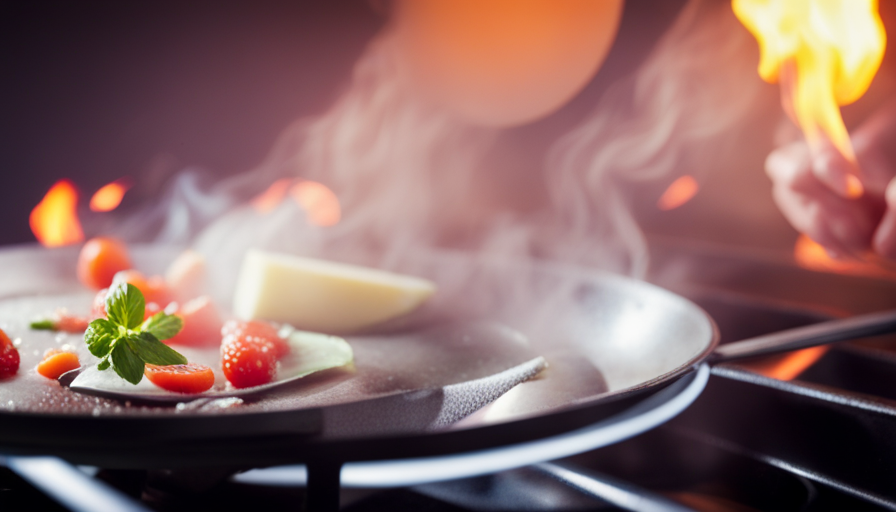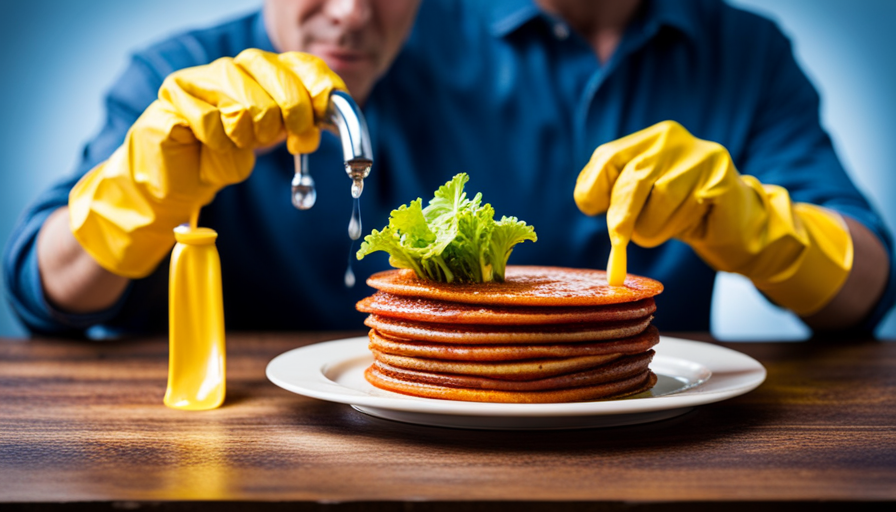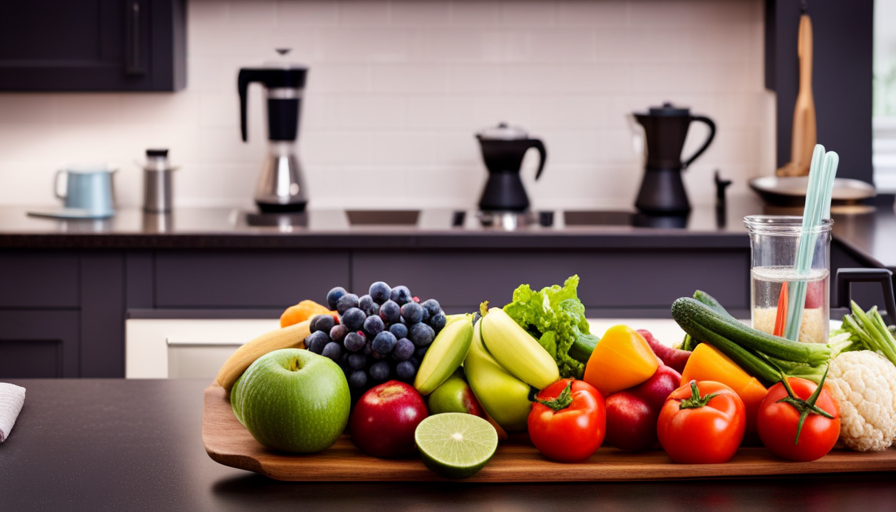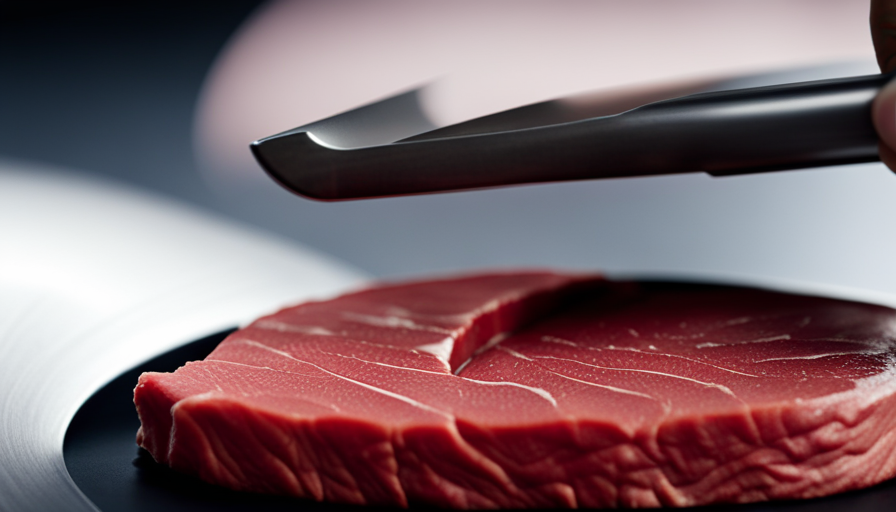Are you always feeling nervous when you cook a meal, worried about potential hidden dangers in your raw food? Fear not! Our comprehensive guide will show you how to effectively eliminate bacteria from your uncooked food, ensuring a safe and healthy dining experience for you and your loved ones.
Food safety is of paramount importance, as it directly affects our well-being. Understanding common foodborne pathogens is the first step in combating them. But fear not, for we will equip you with the knowledge and techniques to tackle these microscopic foes head-on.
Proper washing techniques for raw food are essential in removing harmful bacteria. We will delve into the nitty-gritty details, providing you with step-by-step instructions on how to cleanse your produce effectively.
Additionally, we will explore the usage of natural disinfectants, a safe and eco-friendly alternative to chemical-based cleaners.
Sanitizing surfaces and utensils is another crucial aspect of killing germs on raw food. We will guide you through the best practices to ensure a germ-free food preparation environment. Moreover, understanding the right cooking temperatures to kill germs will give you the confidence to serve perfectly safe and delicious meals.
To prevent cross-contamination, we will enlighten you on the proper techniques for handling raw food. By implementing good hygiene practices, you can significantly reduce the risk of spreading harmful bacteria.
However, we understand that food safety can be a complex subject. That’s why we recommend seeking professional guidance to navigate the intricacies of raw food hygiene. With their expertise, you can rest assured that you are taking all the necessary precautions to safeguard your health.
So, embark on this journey with us, and together, we will conquer the invisible army of germs that threaten our well-being. Prepare to arm yourself with knowledge, techniques, and a scientific understanding of how to kill germs on raw food. Your peace of mind and the safety of your loved ones depend on it.
Key Takeaways
- Proper washing techniques are essential for removing harmful bacteria from raw food.
- Natural disinfectants can be used as safe and eco-friendly alternatives to chemical cleaners.
- Surfaces and utensils should be properly sanitized to create a germ-free food preparation environment.
- Cooking food to the recommended internal temperatures is crucial for killing germs.
Importance of Food Safety
Make sure you’re practicing proper food safety to keep yourself and others safe from harmful bacteria. Foodborne illness prevention is crucial when it comes to handling raw food. Bacteria such as Salmonella, E. coli, and Campylobacter can be present in raw foods, causing severe illness if consumed.
To prevent this, it’s important to follow food handling guidelines.
Firstly, always wash your hands thoroughly with soap and warm water before and after handling raw food. This helps to remove any potential bacteria on your hands.
Additionally, make sure to separate raw foods from ready-to-eat foods to avoid cross-contamination. Use separate cutting boards, utensils, and plates for raw and cooked foods.
Furthermore, it’s essential to cook raw food to the proper internal temperature. Using a food thermometer, ensure that meat, poultry, and seafood reach their recommended temperatures. This kills any bacteria that may be present.
Refrigeration is also a key factor in food safety. Keep perishable foods refrigerated at or below 40°F (4°C) to slow down the growth of bacteria. Remember to thaw frozen foods in the refrigerator or using the microwave, not at room temperature.
By following these food handling guidelines, you can minimize the risk of foodborne illness and ensure the safety of yourself and those around you. Stay informed and practice proper food safety techniques to keep harmful bacteria at bay.
Understanding Common Foodborne Pathogens
Discover the hidden dangers lurking within the delicate textures and vibrant colors of uncooked culinary creations, as you embark on a quest to shield your plate from invisible adversaries. Understanding common foodborne pathogens is essential in preventing contamination and the subsequent risk of foodborne illnesses.
Take a closer look at these microscopic culprits that can wreak havoc on your health:
-
Salmonella: This bacteria can be found in raw eggs, poultry, meat, and even fruits and vegetables. It causes symptoms such as diarrhea, abdominal cramps, and fever. Proper cooking and handling of raw foods can help eliminate this pathogen.
-
E. coli: This bacterium is commonly found in undercooked ground beef, raw milk, and contaminated water. It can cause severe abdominal pain, bloody diarrhea, and even kidney failure. Ensuring that ground beef is cooked to a safe internal temperature can help kill any E. coli present.
-
Listeria: This bacterium is found in uncooked or contaminated ready-to-eat foods, such as deli meats, soft cheeses, and smoked seafood. Listeria can lead to flu-like symptoms, meningitis, and even miscarriage in pregnant women. Proper storage and handling of these foods is crucial in preventing Listeria contamination.
By understanding these common foodborne pathogens and following proper food safety practices, you can minimize the risk of contamination and protect yourself and your loved ones from the harmful effects of foodborne illnesses. Stay vigilant and prioritize safe food handling to enjoy your meals with peace of mind.
Proper Washing Techniques for Raw Food
As you delve into the world of food safety, immerse yourself in the art of properly washing and cleansing your fresh ingredients, creating a pristine canvas for your culinary creations. Safe handling and preventing contamination are crucial steps in ensuring the safety of your raw food.
First and foremost, always wash your hands thoroughly with soap and warm water before and after handling raw food. This simple step helps eliminate any potential germs that may be present on your hands. Additionally, make sure to clean all surfaces, utensils, and cutting boards that come into contact with raw food to prevent cross-contamination.
When it comes to washing raw fruits and vegetables, rinse them under cool running water. Gently rub the surface of the produce with your hands or a vegetable brush to remove any dirt or bacteria. Avoid using soap or detergents, as they can leave behind harmful residues.
For leafy greens, such as lettuce or spinach, separate the leaves and rinse them individually to ensure thorough cleaning. Pay special attention to the crevices and folds where dirt and bacteria can hide.
Lastly, for firmer produce like melons or cucumbers, use a clean produce brush to scrub the surface before rinsing. This will help remove any dirt or bacteria that may be present.
By following these proper washing techniques, you can significantly reduce the risk of foodborne illnesses and ensure the safety of your raw food.
Using Natural Disinfectants
Using natural disinfectants can be a safe and effective way to ensure the cleanliness of your ingredients and prevent potential contamination. Natural disinfectants, such as vinegar, lemon juice, and hydrogen peroxide, can be just as effective as chemical disinfectants in killing germs on raw food. In fact, some studies have shown that natural disinfectants can even be more effective in certain situations.
When it comes to choosing between natural and chemical disinfectants, there are several factors to consider. Natural disinfectants are generally safer to use and do not leave behind harmful residues that can be harmful to your health. They also tend to be more environmentally friendly. On the other hand, chemical disinfectants may be more effective in killing certain types of germs and may have a longer shelf life.
If you prefer to use natural disinfectants, there are several homemade disinfectant recipes that you can try. For example, a mixture of vinegar and water can be used to clean fruits and vegetables. Lemon juice can also be used as a natural disinfectant, especially for cutting boards and other food preparation surfaces. Additionally, hydrogen peroxide can be used to disinfect kitchen utensils.
Using natural disinfectants can be a great way to kill germs on raw food. They are safe, effective, and environmentally friendly. Try out some homemade disinfectant recipes and see how they work for you.
Sanitizing Surfaces and Utensils
To ensure the cleanliness of your kitchen, start by sanitizing surfaces and utensils to create a safe and hygienic cooking environment. Proper disinfection techniques and effective cleaning methods are essential in preventing the spread of germs on raw food. Here are five important steps to follow:
-
Use hot, soapy water: Wash surfaces and utensils with hot water and a mild detergent to remove dirt and grime. This will help eliminate any visible debris that may harbor harmful bacteria.
-
Rinse thoroughly: After cleaning, rinse all surfaces and utensils with clean water to remove any remaining soap residue.
-
Use a sanitizing solution: Prepare a sanitizing solution by mixing one tablespoon of bleach with one gallon of water. Apply this solution to surfaces and utensils, ensuring they are completely covered. Leave the solution on for at least one minute before rinsing with clean water.
-
Use a food-safe disinfectant: Look for disinfectants specifically designed for use in food preparation areas. Follow the manufacturer’s instructions for proper use and ensure that the product is safe for contact with food.
-
Change cleaning cloths regularly: Cleaning cloths can harbor bacteria, so it’s important to change them frequently. Use disposable cloths or wash reusable ones in hot water with bleach to kill any germs.
By following these proper disinfection techniques and effective cleaning methods, you can reduce the risk of foodborne illnesses and create a safe cooking environment for you and your family.
Safe Storage Practices
Proper storage practices are crucial for maintaining the safety and quality of your food. When it comes to safe handling and preventing contamination, it’s important to follow a few key guidelines.
First, always store raw food in sealed containers or bags to prevent cross-contamination with other foods. This will help to avoid the spread of harmful bacteria.
Additionally, keep raw food separate from ready-to-eat foods in the refrigerator to minimize the risk of contamination.
To further prevent the growth of germs on raw food, it’s important to store it at the proper temperature. Refrigerate perishable items, such as meat, poultry, and seafood, at or below 40°F (4°C) to slow down bacterial growth. Freezing raw food is also an effective way to kill germs, as the low temperatures inhibit their growth. Remember to label and date all stored raw food to ensure that it’s used within a safe time frame.
Lastly, regularly clean and sanitize your refrigerator and food storage areas to prevent the buildup of bacteria. Keep surfaces clean by washing them with hot, soapy water, and use a sanitizing solution to eliminate any remaining germs.
By following these safe storage practices, you can effectively reduce the risk of foodborne illnesses and ensure the safety of your raw food.
Cooking Temperatures to Kill Germs
Now that you’ve learned about safe storage practices to prevent the growth of harmful bacteria on raw food, let’s shift our focus to cooking temperatures and how they play a crucial role in killing germs. Proper cooking techniques are essential to ensure the safety of your food and protect against foodborne illnesses.
When you cook food, it’s important to reach and maintain a sufficiently high temperature to kill any potential pathogens that may be present. Different types of food require different cooking temperatures. For example, poultry, such as chicken or turkey, should be cooked to an internal temperature of at least 165°F (74°C), while ground meats, like beef or pork, should reach a minimum internal temperature of 160°F (71°C). Seafood, on the other hand, should be cooked to an internal temperature of 145°F (63°C).
By cooking your food to these recommended temperatures, you can effectively eliminate harmful bacteria, viruses, and parasites that may cause foodborne illnesses. Remember to use a food thermometer to accurately measure the internal temperature of your cooked food. Additionally, make sure to allow your food to rest for a few minutes after cooking, as residual heat will continue to destroy any remaining germs.
Now that you understand the importance of cooking temperatures in killing germs, you can confidently handle and prepare raw food while minimizing the risk of foodborne illnesses.
Avoiding Cross-Contamination
While cooking, it’s crucial to be mindful of avoiding cross-contamination to ensure the safety of your meal. Cross-contamination occurs when harmful bacteria from one food item is transferred to another, potentially leading to foodborne illnesses.
To prevent cross-contamination and practice safe food handling, follow these guidelines:
-
Separate raw foods: Keep raw meats, poultry, seafood, and eggs separate from ready-to-eat foods such as fruits, vegetables, and cooked foods. Use separate cutting boards, utensils, and plates to avoid any contact between raw and cooked foods.
-
Clean and sanitize: Wash your hands thoroughly with soap and water before and after handling raw foods. Additionally, sanitize all surfaces, utensils, and cutting boards that come into contact with raw foods. This helps eliminate any lingering bacteria that may cause cross-contamination.
-
Store properly: Store raw meats, poultry, seafood, and eggs in sealed containers or plastic bags to prevent their juices from dripping onto other foods in the refrigerator. Place them on the bottom shelf to avoid any potential leaks.
-
Use different tools: Use separate knives, tongs, and other cooking utensils for raw and cooked foods to prevent the transfer of bacteria. This ensures that harmful pathogens are not inadvertently spread during the cooking process.
By following these precautions and practicing safe food handling, you can effectively prevent cross-contamination and ensure the safety of your meals.
Implementing Good Hygiene Practices
To keep yourself and your loved ones safe, it’s important to incorporate good hygiene practices into your cooking routine. By following these hygiene tips, you can prevent bacterial growth and reduce the risk of foodborne illnesses.
First and foremost, always wash your hands thoroughly before and after handling raw food. Use warm water and soap, scrubbing for at least 20 seconds to ensure all germs are removed.
Additionally, make sure to regularly clean and sanitize all cooking utensils, cutting boards, and countertops to prevent cross-contamination.
When preparing raw food, avoid touching your face, hair, or any other surfaces that may harbor bacteria. Use single-use disposable gloves if necessary, but remember to change them frequently to maintain cleanliness.
Furthermore, it’s essential to store raw food properly. Keep it separate from ready-to-eat foods to avoid cross-contamination. Raw meats, poultry, and seafood should be stored in sealed containers on the bottom shelf of the refrigerator to prevent any potential drips or leaks from contaminating other foods.
Lastly, be mindful of your clothing. Avoid cooking in loose-fitting sleeves or clothing that may come into contact with raw food. Use aprons and hairnets to minimize the risk of transferring germs.
By implementing these good hygiene practices, you can effectively kill germs on raw food and ensure the safety of your meals. Stay vigilant and prioritize hygiene to protect yourself and your loved ones from harmful bacteria.
Seeking Professional Guidance for Food Safety
If you really think you know everything about food safety, by all means, ignore the need for seeking professional guidance. However, if you want to ensure the utmost safety of your raw food, it’s highly recommended to consider professional resources and consulting services.
Professional resources can provide you with valuable information and guidelines on how to kill germs on raw food. They often offer comprehensive advice on proper handling, storage, and cooking techniques to minimize the risk of foodborne illnesses. These resources may include websites, books, articles, and even online courses that are specifically designed to educate individuals on food safety.
In addition to professional resources, consulting services can provide personalized assistance and guidance tailored to your specific needs. Food safety consultants are trained experts who can assess your current practices, identify potential risks, and offer practical solutions to ensure the safety of your raw food. They can also help you develop and implement effective food safety management systems.
By seeking professional guidance, you can benefit from the knowledge and expertise of professionals who have extensive experience in the field of food safety. They can provide you with the latest research, best practices, and industry standards, helping you make informed decisions to kill germs on your raw food and protect the health of yourself and others.
Frequently Asked Questions
What are the most common foodborne pathogens found on raw food?
The most common foodborne pathogens found on raw food include Salmonella, E. coli, Campylobacter, and Listeria. Proper food handling is crucial to prevent their contamination.
Effective disinfectants, such as chlorine-based solutions or hydrogen peroxide, can be used to kill germs on raw food. However, it’s important to note that thorough cooking is the most reliable method to eliminate these pathogens.
Washing raw food alone may not be sufficient to ensure food safety.
Can using natural disinfectants effectively kill germs on raw food?
Using natural disinfectants on raw food can be an effective way to kill germs. However, it’s important to note that not all natural disinfectants are equally effective against all types of pathogens. Some natural disinfectants, such as vinegar and lemon juice, have been shown to have antimicrobial properties and can help reduce the risk of foodborne illnesses. However, it’s still crucial to handle raw food properly, including washing it thoroughly and cooking it to the recommended temperature, to ensure the complete elimination of harmful germs.
How long can raw food be safely stored before it becomes a breeding ground for bacteria?
Raw food can be safely stored for a limited duration before it becomes a breeding ground for bacteria. The storage duration depends on the type of food and the storage conditions.
Perishable foods like meat, poultry, seafood, and dairy products should be stored in the refrigerator and consumed within their recommended storage times to prevent bacterial growth. For example, raw chicken should be consumed within 1-2 days, while raw beef can be safely stored for 3-5 days.
It’s important to follow proper storage guidelines to minimize the risk of foodborne illnesses.
Are there any specific cooking temperatures that need to be reached in order to kill all types of germs on raw food?
To ensure all types of germs on raw food are eliminated, it’s crucial to reach specific cooking temperatures.
Different germs have different heat sensitivity, but generally, heating food to at least 165°F (74°C) will kill most bacteria, viruses, and parasites. However, for certain pathogens like Salmonella and E. coli, a higher temperature of 160°F (71°C) is required.
It’s essential to use a food thermometer to accurately measure the internal temperature and ensure safe consumption of cooked food.
What are some common sources of cross-contamination that people often overlook when handling raw food?
When handling raw food, it’s crucial to be aware of common mistakes that can lead to cross-contamination. One often overlooked source is improper handwashing techniques. Many people underestimate the importance of washing hands thoroughly with soap and warm water for at least 20 seconds. This step is essential to remove harmful bacteria from your hands and prevent them from spreading to the raw food. Remember, proper handwashing is a simple yet effective way to ensure food safety.
Can Raw Mustard Oil Contain Harmful Germs?
Raw mustard oil can indeed contain harmful germs if not properly processed. To minimize the risk, ensure proper storage and handling. Additionally, removing raw mustard oil smell can be achieved by heating it gently and then straining it to get rid of impurities.
Can Removing Mustard Oil Smell Also Kill Germs on Cooked Food?
Yes, removing raw mustard oil smell can also kill germs on cooked food. Mustard oil has natural antibacterial properties that can help eliminate germs. By getting rid of the pungent smell, you can still benefit from its germ-killing properties when used in cooking.
Conclusion
In conclusion, it’s essential for you to prioritize food safety by implementing proper techniques to kill germs on raw food. By understanding common foodborne pathogens and following thorough washing techniques, using natural disinfectants, sanitizing surfaces and utensils, and cooking food at the right temperatures, you can effectively eliminate harmful bacteria.
Remember to avoid cross-contamination and practice good hygiene habits to further minimize the risk of foodborne illnesses. Don’t hesitate to seek professional guidance to ensure the safety of your meals. Your health and well-being depend on it. So take charge and protect yourself and your loved ones from the dangers of foodborne illnesses.










